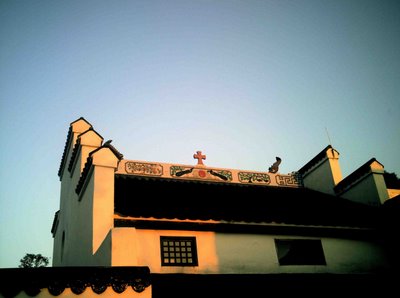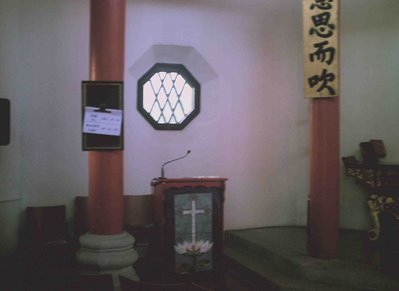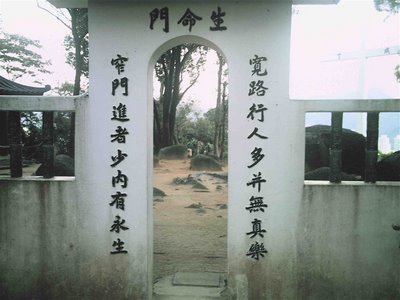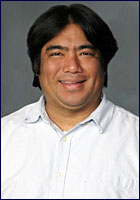Students are gone, I go to Thailand
The students have gone home. I saw them off at the airport. You know how, if your suitcase is over a certain limit, you have to pay extra? Well, it turns out there is another limit beyond that, where the airline won't take your luggage. Many Pepperdine students were above that limit. They scrounged around and found backpacks in each others' luggage, and moved stuff around so that they could check in extra luggage.
Anyway, I'm leaving for Thailand tomorrow (23rd to the 28th).
I have so much to post but I've been pushing it back and back, so there's quite a backlog now. Going to Thailand won't help any--I'm sure I won't be able to post much while I'm there, and I'll have a lot to post when I get back.
The Chinese Christian Pagoda Church
I was recently reading a book on the history of communicating the Christian gospel in China, by Ralph Covell from 1986, titled, "Confucius, The Buddha, and Christ: A History of the Gospel in Chinese". The title isn't very good but he covers a lot of interesting material. It's a good introduction to the history of Christianity in China, though a bit of his history is superceded by new scholarship. Anyway, I've been reading about things happening in Xi'an, Beijing, Shanghai, and so on, and then I come across the following:
The buildings on the top of the small mountain in the Shatin Valley about ten miles from Kowloon City in the New Territories did not have the usual appearance of a church. Most prominent was an octagonal temple, with its roof curved in the familiar lines of Chinese architecture. Within this place for meditation and worship there was:
[An] altar in beautiful Chinese style, with a red lacquer finish and adorned with golden symbols--the lily of purity, the cross of sacrifice, the sun of righteousness, the fire and water of the Spirit's cleansing, the swastika of cosmic unity and perfect peace, the fish of Eastern and Western sanctity, and the Greek monogram for Christ. Red candles, so often used in Chinese ceremonies, were used on the altar as was incense whose ascending smoke and fragrance were symbols of aspiration [Noren, 14].
Even more symbolic than the temple decor was the entrance into this complex of buildings--above the gate, a cross rising out of a lotus to show that the best of Buddhism was fulfilled in Christ. The title was also unique, Dao Feng Shan--"The moutnain from which the Logos wind, the Christ-Spirit, blows" [Reichelt, "Buddhism," 162]. The Dao, that ancient Chinese term signifying way, principle, reason, doctrine or speech, was identified with God's eternal Logos, manifest now in the incarnate Christ.
In formulating the gospel in Chinese, Protestant missionaries in one way or another had to speak in the context of a pervasive Buddhism that had been in China for eighteen hundred years. Karl Reichelt, with his innovative approach at Dao Feng Shan, was hardly typical of the missionary community...
The first thing to catch my attention is the place: Sha Tin is two stops away on the KCR railway. Kowloon is where I'm living now! So I decided to find the place.
It turns out it's not too hard to get to. Go on the KCR and get off on the Sha Tin stop, then go outside where the buses are. Turn left and go down the ramp. There is a "village" named Pai Tau (the "village" is smaller than some of the shopping malls here) and a sign pointing to "Tao Fong Shan". You go up a steep ramp (and sometimes second-guessing yourself because it's such a steep hill--you hope you're on the right path). It's about 10-15 minutes before you reach a road with another sign to the place.
The place is really cool. I'll stop talking now and let you see it.

The entrance here is circular, as you find in many Chinese (especially Taoist) temples. The building to your right has this on the top:

And the pagoda in the distance looks like this up close:

It's actually a church buildling, in Chinese architectural style. Here's the inside:

to the left is the lectern

and outside is a bell somewhat in between a Western and an Eastern style:

The site overlooks a Buddhist cemetery in the valley:

A little path brings you to a large cross on a hillside. The cross is in a Chinese garden, with a gateway. The gate into it is Chinese:

On top it says, "The Gate of Life". To the right and left are the words are the words of Jesus, and here I will try to translate the Chinese instead of adhering to an English translation of the Greek: "On a wide road go many more people and do not find true happiness. Into the narrow gate enter few people, and receive eternal life." (A more familiar translation goes: "Wide is the gate and broad is the road that leads to destruction, and many find it. But small is the gate and narrow is the road that leads to life, and only a few find it." Matthew 7:13-14).
As you enter the dominating view is that of the cross, with the last words of Jesus, "It is finished", written in Chinese:


Elsewhere in the Cross garden, there's a stone with Chinese writing on it. I've seen stones like these at Taoist temples before: they contain two or four Chinese characters on it, and you're supposed to contemplate what the characters together mean. The four characters here say, "Life, Located, Lord, Inside". This is a bit more literal than the mind-riddles you see in other places. Maybe that's the point, though. Or maybe it's for Chinese who are not as familiar with Christianity, to help them see as mystical something we Westerners say all the time.

There's a pavilion with scenes from the gospels and a description. Most of these pictures didn't come out. The only one I was almost able to salvage using software was this one:

The text to the left (that photo didn't come out at all so I'm doing this from memory) talks about Jesus calling some fishermen to be His disciples. He says, "I will make you fishers of men". Note that everyone looks Chinese. Just as in the West, all the pictures of the disciples and Jesus make them all look like Europeans.
When you have seen all of this, you exit the garden through the same gate, but this time you see the following text:

The top says, "Universal love", and the text on the sides say, "As you go to all under heaven, tell the gospel, give it to ten thousand nationalities to hear". A more typical translation of Matthew 28:19-20 is "Go and make disciples of all nations, baptizing them in the name of the Father, of the Son, and of the Holy Spirit, and teaching them to obey everything I have commanded you."
So as you enter the garden, it says, "few enter it to receive eternal life", and after you have seen it all, it says, "Go and tell others."
Very moving, for a Christian. At the time, though, there were lots of concerns by other missionaries about this Norwegian's crazy ideas--was it syncretism?














